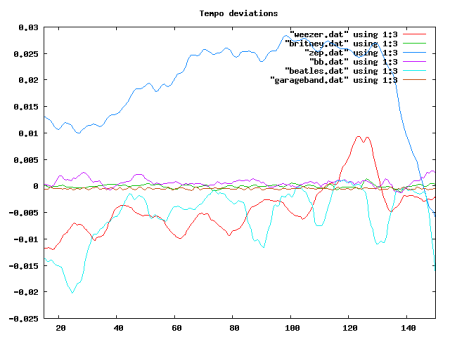When The Rhythm Just Clicks
Drums are often the most problematic instrument for bands; in the real world, drum kits are large, cumbersome and expensive things, and drum machines tend to lack the sort of natural groove that a real drummer can bring…
Following The Click
Despite the fact that a drummer’s great advantage over a programmed loop is that he can make real-time adjustments to the tempo of a track, many popular rock songs are actually recorded to a click track.
Paul Lamere has used the Echo Nest SDK to discover a selection of songs that use click tracks, and compared them to songs that don’t.
In the graph below, tempo variations across the duration of the songs are plotted – songs recorded to click tracks show as roughly horizontal lines, but freely recorded tracks display distinct tempo variations at various sections.

Drumming Up Some Support
So why do bands record to a click track at all? Well, a click track recording is much easier to process in post-production, as everything will be lining up on the grid. Certain types of music demand (or require) a lot of post-work to get them to sound ‘right’ – particularly when dealing with popular music.
Songs that are more about the recording and the performance – for example, jazz or classical – would not be well served by a click track.
Drums For Computer Music
If you work entirely within a DAW, you may never need to record a drum kit – which is good, because recording drums is quite difficult. Fortunately, there are plenty of high-quality sampled kits out there to choose from, recorded by professional engineers in top-notch studios.
If you want the feel of a real drummer in your track, you can try some MIDI grooves. These are recordings of an actual drummer’s performance transferred to MIDI, and most drum software will have a batch of these included. For example, the Reason Drum Kits refill has a selection of grooves that can add a bit of extra life to any track…